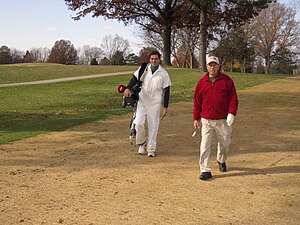Caddie
In golf, a caddy (or caddie) is the person who carries a player's bag, and gives insightful advice and moral support. A good caddy is aware of the challenges and obstacles of the golf course being played, along with the best strategy in playing it. This includes knowing overall yardage, pin placements and club selection. A caddy is not usually an employee of a private club or resort. He is classified as an "independent contractor," meaning that he is basically self employed and does not receive any benefits from his association with the club. Some clubs and resorts do have caddy programs, although benefits are rarely offered.
Etymology
The term caddie comes from the gascon Occitan capdèth or capdet, meaning chief then younger boy (become cadet in French and refers to the Cadets de Gascogne, the captains serving in the French army in the 15th century were the youngest sons of the aristocratic families of Gascony). The term caddie or cadie first appeared in the English language in the year 1634.[1]
Types of caddying
Traditional caddying involves both the golfer and the caddie walking the course. The caddy is in charge of carrying the player’s bag, with the caddie out in front of the player. This is the most common method used in golf clubs and is the only method allowed in the PGA (Professional Golf Association) and LPGA (Ladies Professional Golf Association).
"Fore-Caddying" entails the caddie running while the players ride in carts. The fore-caddy will give a hole description and then run ahead to spot the players tee shots. The caddie then gets the players yardage (either with a laser, course knowledge, or sprinkler heads) while the players drive their carts from the tee to their shots. The caddy runs ahead again to spot the golfers next shots. This process is continued until the players reach the green. Once on the green the caddie will read greens (if asked per proper golf etiquette), clean golf balls (if asked), fix ball marks, and attend the flag if asked. The caddie is also responsible for raking traps and filling divots on the course. Caddies will help with club selection, reading greens, weather variables, and marking balls on the green but should only do so if asked to by the player. More than anything else, the caddy is there to make the players round enjoyable by taking care of menial tasks, speeding up play, and providing mental support if asked.
Caddy Ranks

Most clubs use a ranking system. Caddies will start as a trainee, and be promoted through the ranks of Intermediate, Captain, Honor, and finally Championship. Championship is reserved for only the best caddies. The intermediate and captain ranks can usually be obtained within the first year of caddying, and the honor rank is usually obtained in the second or third year of caddying. Championship takes at least 6 years and often as many as 10 years to obtain.
Employment
Many professionals working in the golf industry started as a caddy.
Weekly schedule
Caddies are most frequently employed at clubs on weekends, when the majority of country club golf takes place. Some (but usually not as many) opportunities to caddy exist during the week, as well. Additionally, caddies are often allowed to play the course at which they caddy for free, usually on a Monday (the day that most private clubs choose to close their course for maintenance). On pro golf tours, professional caddies accompany their player to all events, which usually take place from Thursday through Sunday. Additionally, the player may hire their caddy to carry their bag for them during training sessions and practice rounds.
Pay scale
At most clubs, caddies are paid at the end of the round by cash, or receive a payment ticket for which they can redeem their wages in the clubhouse. Generally, the player will tip the caddy based on their performance during the round, with extra money given for exemplary work. Most American club caddies earn between $35 and $60 per bag, though newer caddies will often earn less and more experienced caddies or caddies working during a tournament, high-stakes match, or 4-Day member-guest will often earn significantly more, upwards of $100 per round, per bag, at times. It is considered acceptable to ask a professional at the course what the average pay for a caddie is, as courses differ.
In a professional golf tour setting, a player often pays their caddy a percentage of their winnings, which can be as high as 10%. A common pay scale is 5% for making the cut, 7% for a top 10, and 10% for a win. The caddy also usually receives a salary, as the player may not be guaranteed to win money at every tournament the player enters.
Attire
- Collared shirt
- Khaki shorts or pants
- Gym shoes or golf shoes (lots of walking and standing)
- Smock
- Towel
- Hat
- Divot tool
- pencil, scorecard, and pin sheet
- small amount of sand (used to fill in divots)
Notes and references
- ^ "Derivation of Golf Words Fore and Caddie or Caddy". Retrieved on 2008-12-19
